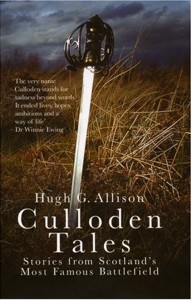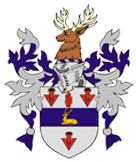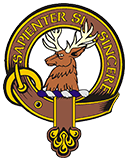Battles of Invernhaven And Perth – 1300s

Culloden Tales – Cover Art
Perhaps we need to view the setting more generically: in all of the predominant narratives, strains between two clans erupted into a full-blown, albeit small-scale, war that became so problematic it caused intervention by the government. They were ordered by the King to appear for trial by combat at the North Inch. OK, generic setting. But, here’s where we are thrown and have to pause: who was ordered? As I hinted earlier, a version that appears quite often in “the literature” on the matter holds the conflict took place between the Clans Davidson and MacPherson. The prospect would seem consistent with the history regarding the Battle of Invernahavon if the argument between the two clans created a deeper resentment, but there is no evidence to suggest this to be true. Furthermore, several “authorities” have rejected the Davidson-MacPherson notion en lieu of other candidates for participation. It has been suggested – and you have likely all seen some, if not all of these in print – that it was the other clans of the Chattan Confederation versus the Davidsons; Clan Chattan versus Clan Cameron; Clan Chattan versus Clan Cumming; Clan Kay against Clan Quehle; or the Clan Cameron versus Clan Quehle 8. The list goes on, but I likely don’t need to explain the mess this creates.
So, not only are we confronted by the absence of reasons for our involvement at the North Inch, we must now wrestle with the “who” of the equation. Suffice it to say, if we don’t know who the actual players were, it is possible to correlate a period of strife from any two clans’ histories with the North Inch battle. Perhaps more to the point, without identifying the actors it is impossible for us to assert that one version of a tale is more (or less) factual than another. So the questions still remain: what can we give clout to and what can we dismiss? Can we trust any of the “facts” so far? Perhaps it is time to look at the problem from a fresh perspective. Let’s add to deductive reasoning and closer scrutiny a new spin on the history of the sons (and daughters) of David and the North Inch, though this time with the benefit of credible support. We can use this unsullied canvas to paint a new picture; one lacking the familiar but distracting brushstrokes of previous ideas – if we don’t want to view Scott’s portrait as the final masterpiece, that is.
Not so Fast, Scott!
The new variant is outlined in the 2007 publication Culloden Tales: Stories from Scotland’s most Famous Battlefield by Hugh G. Allison 9. You might ask yourself what this book and its contents could have to do with anything we’re talking about, considering the title. In fact, glancing at the introduction and even the first few short chapters, the book seems to be no more than a collection of anecdotes and reflections picked up from visitors, site workers, and scholars who frequent or operate the battlefield and its memorials. However, you will rapidly find that the major chapters focus on historical accounts and examine each clan present at Culloden individually, in most instances by describing the causes or series of events that contributed to bringing these clans into the ’45. In most of these cases, the author actually reaches back to the beginning of each group’s known history. Since it was present at Culloden, the Clan Chattan has a chapter dedicated to it and, since we filled a vital role in its membership, the Davidsons are discussed in terms of it as a whole – in rather amazing detail. It is noteworthy that most of the information in the book has been verified or at least given support by historians and other researchers through the NTS who, in many cases, have data to back it. Coupled with this and other research, a strong position is established from which the truth about Clan history can regroup.
Allison begins with the lineages and resultant positions of seniority of the Clans Davidson, MacPherson, and MacIntosh in the Confederation – the first two having descended from one Gilliechattan Mhor, and the latter inheriting the Chiefship through marriage 10 – and goes forward to the Battle of Invernahavon. Allison’s account does not disagree with the descriptions of the battle that we’ve discussed, so I won’t belabor the point. However, he does preface the event by stating there were tensions between the Camerons and the whole of Clan Chattan sometime prior to 1380 over land and boundaries. At first, these consisted of little more than a pattern of arguments and grudgingly-consented-to resolutions. Let’s look at this point before moving on: in other accounts, it has been inferred that the stress between the two clans – whoever they may have been – was more-or-less short-lived before the explosion that resulted to blows. Allison suggests that the incursion of Camerons onto Davidson/Chattan lands was simply the “straw that broke the camel’s back,” and clearly nowhere near the first offense.
Another preface to this part of the story is a focus on the familial and mutually beneficial ties between the members of Clan Chattan 11, most of all between the three most senior members. Therefore, it seems the notion that the MacPhersons and Davidsons had deeper problems, as is described in the Davidson versus MacPherson accounts, is already suspect. We can’t know what The MacPherson was thinking as he and his clan removed themselves from the battle at Invernahavon, nor what went through their minds as they watched their kin be cut down. What does seem clear, however, is that there was guilt for abandoning their brothers in time of urgent need. Why else would the MacIntosh bard’s song have impacted them as it did? Of course, this is purely speculation on my part, but the psychology of it seems sound. The point is, the argument over position on the battlefield does not seem to have originated from anything other than the singular cause. There is nothing in the history books to suggest an animosity between the two clans or that would support the anecdotal accounts that came into favor after the 16th and 17th centuries. It appears that the retribution enacted on the Camerons by the MacPhersons may have been enough of an apology for us and for the rest of Clan Chattan. In fact, Allison’s description of politics following Invernahavon infers the formation of increasingly tighter bonds of the clans within Clan Chattan.
We fast forward a little here to elaborate further on ties between Chattan clans. In the predominant tales, the outcome of all the fighting in which we were involved pushed the Davidsons into “hiding” and obscurity. The new account does not offer any new insight on this, and perhaps we have to assume it is accurate, even without being certain to what degree, if any, the North Inch battle contributed to the actual, cumulative losses. Nevertheless, Allison’s work again suggests some holes in previous theories, particularly in those that take the account further and claim obscurity led in the end to all but our total disappearance.

